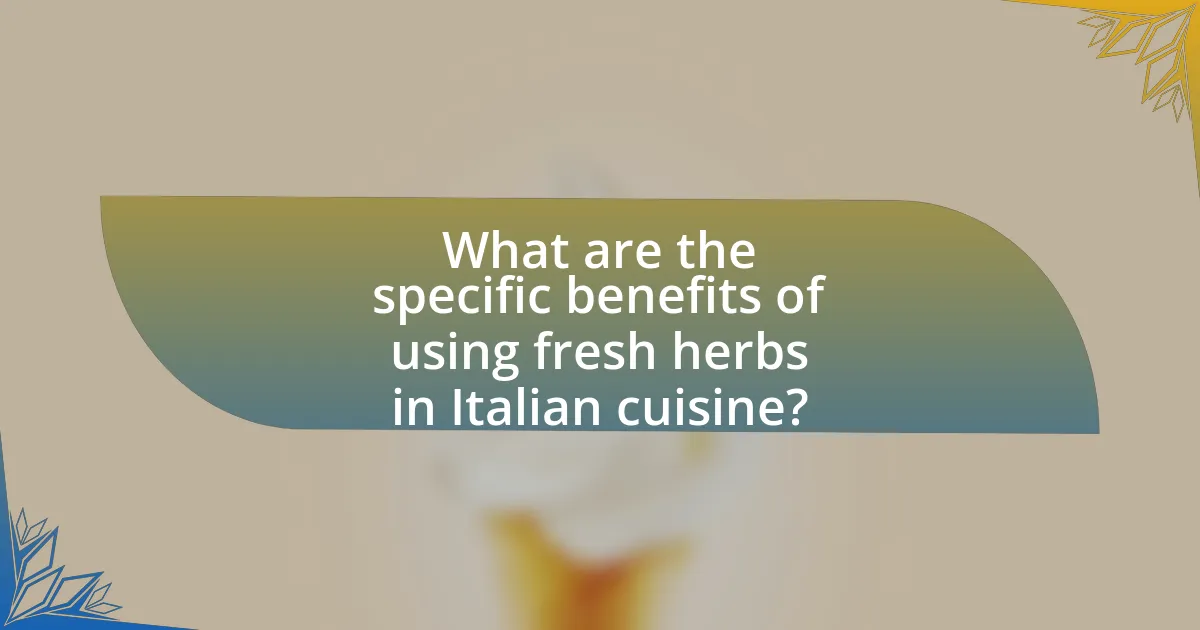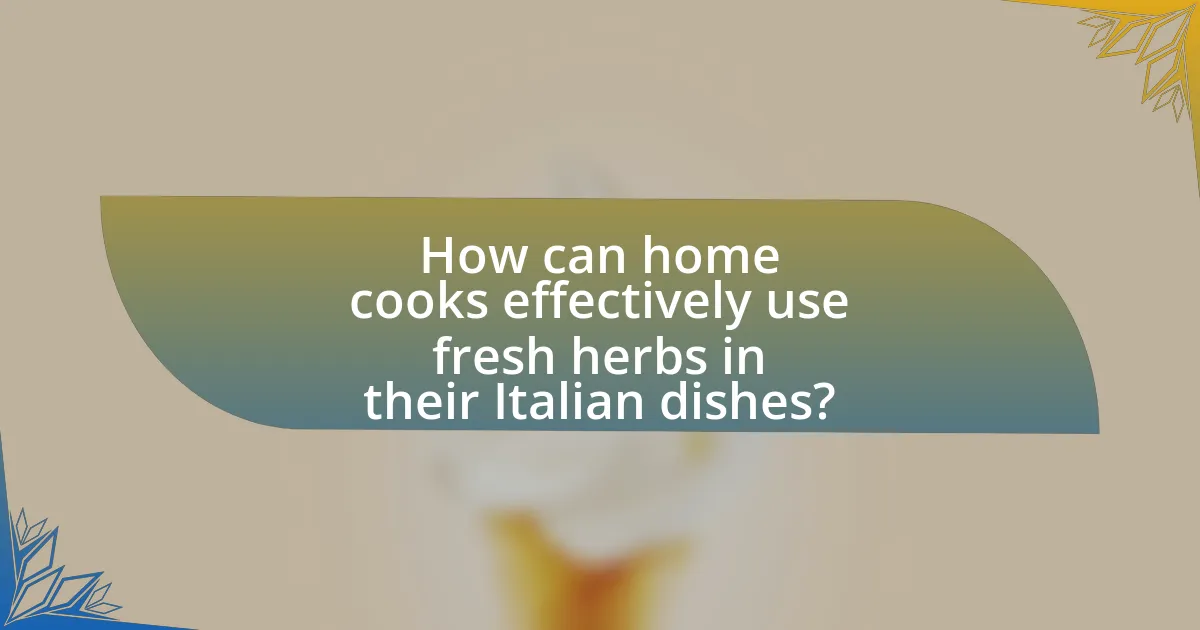Fresh herbs are a fundamental component of Italian cuisine, significantly enhancing the flavor, aroma, and visual appeal of dishes. Key herbs such as basil, parsley, oregano, and rosemary are integral to traditional recipes, contributing not only to taste but also to the authenticity and healthfulness of meals. The article explores the role of fresh herbs in flavor enhancement, their nutritional benefits, preferred culinary techniques for their use, and practical applications in both classic and modern Italian recipes. Additionally, it addresses common mistakes to avoid when using fresh herbs and offers tips for selecting and storing them effectively.

What is the role of fresh herbs in Italian cuisine?
Fresh herbs play a crucial role in Italian cuisine by enhancing flavor, aroma, and visual appeal in dishes. They are integral to traditional recipes, with basil, parsley, oregano, and rosemary being among the most commonly used herbs. For instance, basil is essential in pesto and tomato sauces, while parsley is often used as a garnish and flavor enhancer in various dishes. The use of fresh herbs not only elevates the taste but also reflects the Italian emphasis on using high-quality, fresh ingredients, which is a hallmark of the cuisine. Studies show that fresh herbs contain essential oils and antioxidants, contributing to both flavor and health benefits, thus solidifying their importance in Italian culinary practices.
How do fresh herbs enhance the flavors of Italian dishes?
Fresh herbs enhance the flavors of Italian dishes by adding vibrant aromas and complex tastes that elevate the overall culinary experience. For instance, basil contributes a sweet, peppery flavor that complements tomatoes in sauces, while oregano provides a warm, earthy note that enriches meat dishes. Studies have shown that fresh herbs contain essential oils and compounds that not only intensify flavors but also offer health benefits, such as antioxidants. The use of fresh herbs in Italian cuisine is rooted in tradition, with specific herbs like parsley, rosemary, and thyme being integral to classic recipes, thereby reinforcing their role in flavor enhancement.
What are the most commonly used fresh herbs in Italian cooking?
The most commonly used fresh herbs in Italian cooking are basil, parsley, oregano, and rosemary. Basil is essential for dishes like pesto and Caprese salad, while parsley is frequently used as a garnish and in sauces. Oregano is a key ingredient in pizza and tomato sauces, and rosemary is often used to flavor meats and roasted vegetables. These herbs not only enhance the flavor of Italian dishes but also contribute to the cuisine’s aromatic profile, making them integral to traditional recipes.
How do fresh herbs contribute to the authenticity of Italian cuisine?
Fresh herbs are essential to the authenticity of Italian cuisine as they enhance flavor, aroma, and visual appeal. The use of herbs like basil, oregano, and parsley is deeply rooted in Italian culinary traditions, reflecting regional ingredients and seasonal availability. For instance, basil is a key ingredient in traditional pesto, a dish originating from Liguria, showcasing the local herb’s significance. Additionally, fresh herbs contribute to the healthfulness of dishes, aligning with the Mediterranean diet, which emphasizes fresh, natural ingredients. This reliance on fresh herbs not only preserves the integrity of traditional recipes but also connects modern Italian cooking to its historical roots.
Why are fresh herbs preferred over dried herbs in Italian cooking?
Fresh herbs are preferred over dried herbs in Italian cooking because they provide a more vibrant flavor and aroma. The essential oils in fresh herbs are more potent and aromatic than those in dried herbs, which can lose their intensity over time. For instance, basil, a staple in Italian cuisine, has a fresh, sweet flavor that is essential for dishes like pesto and Caprese salad, where the herb’s brightness enhances the overall taste. Additionally, fresh herbs contribute to the visual appeal of dishes, adding color and freshness that dried herbs cannot replicate. This preference is rooted in traditional Italian cooking, which emphasizes the use of high-quality, fresh ingredients to achieve authentic flavors.
What are the flavor differences between fresh and dried herbs?
Fresh herbs typically have a brighter, more vibrant flavor compared to dried herbs, which tend to have a more concentrated and sometimes muted taste. The essential oils in fresh herbs are more volatile, providing a fresh aroma and flavor that can enhance dishes significantly. In contrast, the drying process reduces moisture and can diminish some of the herb’s original flavor compounds, leading to a more subdued taste profile. For example, fresh basil has a sweet, peppery flavor, while dried basil often lacks the same intensity and complexity. This difference is crucial in Italian cuisine, where the freshness of herbs like basil, parsley, and oregano plays a vital role in the overall flavor of dishes.
How does the freshness of herbs affect the nutritional value of dishes?
The freshness of herbs significantly enhances the nutritional value of dishes by preserving their essential vitamins, minerals, and antioxidants. Fresh herbs contain higher concentrations of nutrients compared to dried herbs, as the drying process can lead to the degradation of these beneficial compounds. For instance, fresh basil is rich in vitamin K, vitamin A, and flavonoids, which contribute to various health benefits, including anti-inflammatory properties. Studies have shown that fresh herbs can provide up to 50% more antioxidants than their dried counterparts, making them a vital component in maximizing the nutritional profile of Italian cuisine.

What are the specific benefits of using fresh herbs in Italian cuisine?
Using fresh herbs in Italian cuisine enhances flavor, aroma, and nutritional value. Fresh herbs like basil, parsley, and oregano provide vibrant tastes that elevate dishes, making them more appealing and authentic. For instance, basil is a key ingredient in pesto and Caprese salad, contributing to their distinctive flavors. Additionally, fresh herbs contain essential vitamins and antioxidants, promoting health benefits such as improved digestion and reduced inflammation. Studies have shown that fresh herbs can contain higher levels of beneficial compounds compared to dried herbs, reinforcing their importance in culinary practices.
How do fresh herbs impact the healthiness of Italian meals?
Fresh herbs significantly enhance the healthiness of Italian meals by providing essential nutrients and antioxidants. These herbs, such as basil, oregano, and parsley, are rich in vitamins A, C, and K, which contribute to overall health by supporting immune function and reducing inflammation. Additionally, the antioxidants found in fresh herbs can help combat oxidative stress, which is linked to chronic diseases. Studies have shown that incorporating herbs into meals can lower the need for added salt and fat, making dishes healthier while maintaining flavor. For instance, a study published in the Journal of Nutrition highlighted that using herbs can reduce sodium intake without sacrificing taste, promoting better cardiovascular health.
What vitamins and minerals are found in common Italian herbs?
Common Italian herbs such as basil, oregano, parsley, and rosemary contain various vitamins and minerals. Basil is rich in vitamin K, vitamin A, and manganese; oregano provides vitamin K, vitamin E, and calcium; parsley is an excellent source of vitamin C, vitamin K, and iron; while rosemary contains vitamin B6, iron, and calcium. These nutrients contribute to the health benefits associated with consuming these herbs, supporting immune function, bone health, and overall well-being.
How can fresh herbs aid in digestion and overall wellness?
Fresh herbs can significantly aid in digestion and overall wellness by providing essential nutrients and promoting digestive health. Herbs such as basil, parsley, and mint contain compounds that stimulate digestive enzymes, enhance nutrient absorption, and reduce bloating. For instance, peppermint has been shown to relax the muscles of the gastrointestinal tract, alleviating symptoms of indigestion. Additionally, fresh herbs are rich in antioxidants and vitamins, which support the immune system and contribute to overall health. Studies indicate that incorporating herbs into meals can lead to improved digestion and a reduction in gastrointestinal discomfort, highlighting their importance in a balanced diet.
What culinary techniques maximize the use of fresh herbs in Italian cooking?
Chopping, bruising, and infusing are culinary techniques that maximize the use of fresh herbs in Italian cooking. Chopping herbs increases their surface area, releasing essential oils and enhancing flavor in dishes like pesto and sauces. Bruising, achieved by gently crushing herbs, further releases aromatic compounds, making it effective for infusing oils and vinegars. Infusing involves steeping herbs in liquids, allowing their flavors to permeate, which is commonly used in dressings and marinades. These techniques are foundational in Italian cuisine, where the vibrant flavors of fresh herbs are essential for authentic dishes.
How should fresh herbs be prepared for optimal flavor release?
Fresh herbs should be chopped or bruised to release their essential oils and enhance flavor. Chopping increases the surface area, allowing for greater oil exposure, while bruising, achieved by gently crushing the leaves, activates aromatic compounds. Research indicates that the volatile compounds responsible for flavor are released more effectively through these methods, making them essential for maximizing the taste in dishes. For instance, studies show that basil’s flavor compounds are significantly more potent when the leaves are torn or chopped rather than used whole.
What are the best methods for incorporating fresh herbs into sauces and marinades?
The best methods for incorporating fresh herbs into sauces and marinades include finely chopping the herbs to release their essential oils, adding them at the end of cooking to preserve their flavor, and using them in a marinade for several hours to allow the flavors to meld. Finely chopping herbs like basil or parsley enhances their aromatic qualities, while adding them at the end of cooking ensures that their delicate flavors remain vibrant. Additionally, marinating proteins with fresh herbs for a few hours allows the herbs to infuse their flavors deeply, resulting in a more flavorful dish. These methods are widely recognized in culinary practices, particularly in Italian cuisine, where fresh herbs play a crucial role in enhancing the overall taste profile of sauces and marinades.

How can home cooks effectively use fresh herbs in their Italian dishes?
Home cooks can effectively use fresh herbs in their Italian dishes by incorporating them at various stages of cooking to enhance flavor and aroma. For instance, adding herbs like basil, parsley, or oregano early in the cooking process allows their flavors to infuse into sauces and stews, while adding them towards the end preserves their fresh taste and vibrant color. Research indicates that fresh herbs contain essential oils that contribute to their aromatic properties, which can elevate the overall sensory experience of a dish. Additionally, using a combination of herbs can create complex flavor profiles, as seen in traditional Italian recipes that often blend multiple herbs for depth.
What tips can help in selecting and storing fresh herbs?
To select fresh herbs, choose vibrant, green leaves without wilting or browning, as these indicate freshness and quality. When storing fresh herbs, wrap them in a damp paper towel and place them in a plastic bag in the refrigerator to maintain moisture and prolong shelf life. Research shows that proper storage can extend the freshness of herbs by up to two weeks, ensuring they retain their flavor and nutritional value.
How can one ensure the freshness of herbs when purchasing?
To ensure the freshness of herbs when purchasing, one should look for vibrant color, firm texture, and a strong aroma. Fresh herbs typically exhibit bright green leaves without any wilting or browning, indicating they are recently harvested. Additionally, herbs should feel crisp to the touch, as limp or soft leaves suggest age or poor storage conditions. The aroma is also a key indicator; fresh herbs emit a strong, pleasant scent, while older herbs may lack fragrance. Research indicates that herbs lose essential oils and flavor compounds over time, which diminishes their culinary value. Therefore, selecting herbs that meet these freshness criteria is essential for maintaining the quality of dishes in Italian cuisine.
What are the best storage practices for maintaining herb freshness?
The best storage practices for maintaining herb freshness include keeping herbs in a cool, dark place, using airtight containers, and storing them in water or wrapping them in damp paper towels. Storing herbs in the refrigerator can extend their freshness, especially for leafy varieties like basil and parsley, which benefit from being placed upright in a jar with water, similar to cut flowers. Research indicates that proper storage can significantly prolong the shelf life of herbs, with studies showing that herbs stored in water can last up to two weeks longer than those left unprotected.
What are some common mistakes to avoid when using fresh herbs in Italian cuisine?
Common mistakes to avoid when using fresh herbs in Italian cuisine include using dried herbs instead of fresh, which diminishes flavor, and adding herbs too early in the cooking process, leading to loss of their aromatic qualities. Fresh herbs should be added towards the end of cooking to preserve their vibrant flavors. Additionally, not properly washing and drying fresh herbs can introduce grit and affect texture. Overusing strong herbs like rosemary or sage can overpower dishes, while underusing delicate herbs like basil or parsley can result in blandness. These practices are essential for maintaining the authentic taste and quality of Italian dishes.
How can overusing herbs negatively affect a dish?
Overusing herbs can negatively affect a dish by overpowering its flavor profile and creating an unbalanced taste. When herbs are used excessively, they can dominate the dish, masking the natural flavors of the main ingredients and leading to a one-dimensional taste experience. For example, in Italian cuisine, where the harmony of flavors is essential, an overabundance of basil or oregano can overwhelm the subtlety of tomatoes or the richness of olive oil, resulting in a dish that lacks depth and complexity. This imbalance can detract from the overall enjoyment of the meal, as the intended flavors become indistinguishable.
What are the signs of herbs that have gone bad?
The signs of herbs that have gone bad include wilting, discoloration, and a foul odor. Wilting indicates loss of moisture, while discoloration, such as browning or yellowing leaves, suggests deterioration. A foul odor often signifies spoilage due to bacterial growth. Fresh herbs should maintain vibrant color and a strong, pleasant aroma; any deviation from these characteristics typically indicates that the herbs are no longer suitable for use.
What are some practical recipes that highlight the use of fresh herbs in Italian cuisine?
Practical recipes that highlight the use of fresh herbs in Italian cuisine include Caprese Salad, Pesto alla Genovese, and Osso Buco. Caprese Salad features fresh basil, mozzarella, and tomatoes, showcasing the herb’s aromatic qualities. Pesto alla Genovese, made with fresh basil, garlic, pine nuts, Parmesan cheese, and olive oil, is a classic sauce that emphasizes the herb’s vibrant flavor. Osso Buco, a braised veal dish, often incorporates fresh parsley as a garnish, enhancing its presentation and taste. These recipes exemplify how fresh herbs are integral to the flavor profiles and authenticity of Italian dishes.
How can fresh herbs be featured in traditional Italian pasta dishes?
Fresh herbs can be featured in traditional Italian pasta dishes by incorporating them into sauces, garnishing finished plates, and infusing them into the cooking water. For example, basil is commonly used in pesto, a classic Italian sauce made with fresh basil, garlic, pine nuts, and olive oil, which is then tossed with pasta. Additionally, parsley is often sprinkled on top of dishes like spaghetti aglio e olio to enhance flavor and presentation. Furthermore, herbs like oregano and thyme can be added to the cooking water or sauces to impart their aromatic qualities, enriching the overall taste of the dish. These practices highlight the integral role of fresh herbs in elevating the flavors and authenticity of Italian pasta cuisine.
What are some innovative ways to incorporate fresh herbs into modern Italian recipes?
Innovative ways to incorporate fresh herbs into modern Italian recipes include using herb-infused oils, creating herb-based pestos, and incorporating herbs into unexpected dishes like desserts. Herb-infused oils, such as basil or rosemary oil, can enhance the flavor of salads and grilled meats, providing a fresh twist on traditional Italian dishes. Herb-based pestos, made with ingredients like arugula or parsley instead of the classic basil, offer unique flavor profiles that can be used in pasta or as a spread. Additionally, incorporating herbs like mint or thyme into desserts, such as sorbets or cakes, showcases their versatility and adds a refreshing element to sweet dishes. These methods not only elevate the flavor but also align with contemporary culinary trends that emphasize fresh, vibrant ingredients.















